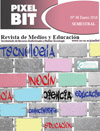Resumen
El objetivo del estudio es analizar las acciones que realizan los estudiantes de la población para la autorregulación del aprendizajes en entornos personales de aprendizaje. Se aplicó un cuestionario a una muestra de estudiantes de la Universidad de Granada (España) que pertenecen a las titulaciones de Pedagogía, Educación Social y Psicopedagogía. Sobre los datos se efectúan pruebas no paramétricas de correlaciones y análisis de varianzas, así como estadística descriptiva e inferencial. Los resultados relacionan las acciones autorregulatorias que realizan los estudiantes y demuestran que estas acciones son homogéneas según titulación, sexo, edad y otras variables en estudio.
Citas
Archee, R. (2012). Reflections on Personal Learning Environments: theory and Practice. Procedia - Social and Behavioral Sciences, 55, 419-428. doi:10.1016/j.sbspro.2012.09.520
Attwell, G. (2007a). E-portfolios - the DNA of the personal learning environment?. Journal of e-Learning and Knowledge Society, 3 (2), 39-61.
Attwell, G. (2007b). Personal learning environments-the future of elearning?. Elearning Papers, 2 (1), 1-7.
Azevedo, R. (2007). Understanding the complex nature of self-regulatory processes in learning with computer-based learning environments: an introduction. Metacognition Learning, 2 (2), 57-65. doi: 10.1007/s11409-007-9018-5
Bandura, A. (1997). Self-efficacy: The exercise of control. New York: Freeman.
Boekarts, M., Pintrich, P. & Zeidner, M. (Eds.) (1999). Handbook of self-regulation. New York: Academic.
Cabero, J., Barroso, J. & Llorente, M. C. (2010). El diseño de entornos personales de aprendizaje y la formación de docentes en TIC. Digital education review, (18), 27-37
Chaves, E., Trujillo, J.M. & López, J.A. (2015). Autorregulación del aprendizaje en entornos personales de aprendizaje en el Grado de Educación Primaria de la Universidad de Granada, España. Form. Univ., 8 (4), en prensa.
Cohen, J. (1988). Statistical power analysis for the behavioral sciences (Second Edition). Hillsdale, NJ: Lawrence Erlbaum Associates, Publishers.
Dabbagh, N. & Kitsantas, A. (2012). Personal Learning Environments, social media, and self-regulated learning: A natural formula for connecting formal and informal learning. The Internet and Higher Education, 15 (1), 3-8. doi:10.1016/j.iheduc.2011.06.002
Drexler, W. (2010). The networked student model for construction of personal learning environments: Balancing teacher control and student autonomy. Australasian Journal of Educational Technology, 26 (3), 369-385.
Ebner, M. & Taraghi, B. (2010). Personal learning environment for higher education. A first prototype. En Proceedings of world conference on educational multimedia, hypermedia and telecommunications (pp. 1158-1166). Chesapeake, VA: AACE.
Gallego, M.J. & Chaves, E. (2014). Tendencias en estudios sobre entornos personales de aprendizaje (Personal Learning Environments -PLE-). EDUTEC, Revista Electrónica de Tecnología Educativa, 49. Recuperado de http://edutec.rediris.es/Revelec2/Revelec49/pdf/Edutec_n49_Gallego_Chaves.pdf
Godwin-Jones, R. (2009). Emerging technologies: Personal learning environments. Language Learning & Technology, 13 (2), 3-9
Howell, D.C. (1997). Statistical methods for psychology (4th ed.). Belmont, CA: Duxbury.
Jin, P. & Low, R. (2009). Enhancing motivation and self-regulated learning in multimedia environments. En Ding-Yee, R., Cheong, B., Rita, M. & Cheung, T. (Eds.). Education policy, reform, and school innovations in the Asia-Pacific Region (pp. 525-547). Hong Kong: Association for Childhood Education International – Hong Kong & Macao (ACEI-HKM).
Johnson, M.W. & Liber, O. (2008). The Personal Learning Environment and the human condition: from theory to teaching practice. Interactive Learning Environments, 16 (1), 3-15. doi:10.1080/10494820701772652
Kruskal, W.H. & Wallis, W.A. (1952). Use of ranks in one- criterion variance analysis. Journal of the American Statistical Association, 47, 583-621. doi: 10.1080 / 01621459.1952.10483441
Leech, N., Barrett, K. & Morgan, G. (2011). IBM SPSS for intemediate statistics, use and interpretation. New York: Taylor and Francis Group, LLC.
Liber, O. & Johnson, M. (2008). Personal Learning Environments. Interactive Learning Environments, 16 (1), 1-2. doi:10.1080/10494820701772645
Maddux, J.E. (2009). Self-efficacy: The power of believing you can. En Lopez, S.J. & Snyder, C.R. (eds.) Oxford Handbook of Positive Psychology (2nd edn) (pp. 335-343). New York: Oxford University Press.
Martínez, A. & Torres, L. (2013). Los entornos personales de aprendizaje (PLE). Del cómo enseñar al cómo aprender. EDMETIC, Revista de Educación Mediática y TIC, 2 (1), 39-57.
Osterlind, S.J. (1989). Constructing tests items. Boston: Kluwer Academic Publishers.
Pintrich, P.R. (Ed.). (1995). Understanding self-regulated learning. San Francisco: Jossey-Bass.
Pintrich, P.R. (2004). A conceptual framework for assessing motivation and self-regulated learning in college students. Educational Psychology Review, 16 (4), 385-407. doi: http://dx.doi.org/10.1007/s10648-004-0006-x
Pintrich, P.R., Smith, D., Garcia, T. & McKeachie, W. (1993). Reliability and Predictive validity and reliability of the Motivated Strategies for Learning Questionnaire (MSLQ). Educational and Psychological Measurement, 53 (3), 801-813. doi: http://dx.doi.org/10.1177/0013164493053003024
Schunk, D.H. (2004). Learning theories: An educational perspective (4th ed.). Upper Saddle River: Pearson Education.
Schunk, D.H. & Zimmerman, B. (2003). Self-regulation and learning. En Reynolds, W.M. &.
Strahan, R.F. (1982). Assessing magnitude of effect from rank- order correlation coeffients. Educational and Psychological Measurement, 42 (3), 763-765. doi: 10.1177 / 001316448204200306
Zimmerman, B.J. (1990). Self-regulated learning and academic achievement: an overview. Educational Psychologist, 25 (1), 3-17. doi:10.1207 / s15326985ep2501_2
Zimmerman, B.J. (2001). Theories of self-regulated learning and academic achievement: an overview and analysis. En B. J. Zimmerman, & D. E. Schunk (Eds.), Self-regulated learning and academic achievement: Theoretical perspectives (pp. 1-37). Mahwah, NJ: Erlbaum.
Zimmerman, B.J. (2008). Investigating self-regulation and motivation: Historical background, methodological development, and future prospects. American Educational Research Journal, 45 (1), 166–183. doi: 10.3102 / 0002831207312909
Zimmerman, B.J. & Cleary, T.J. (2006). Adolescents’ development of personal agency. En Pajares, F. & Urdan, T. (Eds.). Self-efficacy beliefs of adolescents (Vol. 5) (pp. 45-69). Greenwich, CT: Information Age Publishing.
Zimmerman, B.J. & Cleary, T.J. (2009). Motives to self-regulate learning. En Wentzel, K.R. & Wigfield, A. (Eds.). Handbook of motivation at school (pp. 247–264). New York, NY: Routledge.

